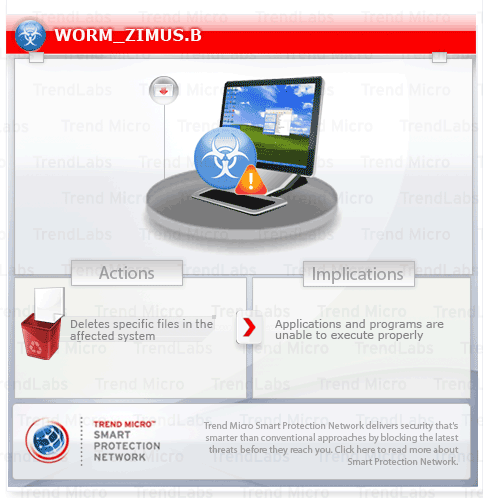WORM_ZIMUS.B
Windows 98, ME, NT, 2000, XP, Server 2003


Threat Type: Worm
Destructiveness: No
Encrypted: No
In the wild: Yes
OVERVIEW
Copies itself in all available physical drives, Propagates via removable drives
Trend Micro has flagged this worm as noteworthy due to the increased potential for damage, propagation, or both, that it possesses. Specifically, it deletes important files that are needed during system bootup.
To get a one-glance comprehensive view of the behavior of this Worm, refer to the Threat Diagram shown below.

This worm may be unknowingly downloaded by a user while visiting malicious websites.
TECHNICAL DETAILS
Varies
PE
Yes
26 Jan 2010
Deletes files
Arrival Details
This worm may be unknowingly downloaded by a user while visiting malicious websites.
Installation
This worm drops the following copies of itself into the affected system:
- %System%\tokset.dll
(Note: %System% is the Windows system folder, which is usually C:\Windows\System on Windows 98 and ME, C:\WINNT\System32 on Windows NT and 2000, or C:\Windows\System32 on Windows XP and Server 2003.)
It drops the following file(s)/component(s):
- %Program Files%\Dump\Dump.exe
- %System Root%\IQTEST\Iqtest.exe
- %System Root%\IQTEST\Readme.txt
- %System%\ainf.inf
- %System%\drivers\Mseu.sys - also detected as WORM_ZIMUS.B
- %System%\drivers\Mstart.sys - also detected as WORM_ZIMUS.B
- %System%\mseus.exe - also detected as WORM_ZIMUS.B
(Note: %Program Files% is the default Program Files folder, usually C:\Program Files.. %System Root% is the root folder, which is usually C:\. It is also where the operating system is located.. %System% is the Windows system folder, which is usually C:\Windows\System on Windows 98 and ME, C:\WINNT\System32 on Windows NT and 2000, or C:\Windows\System32 on Windows XP and Server 2003.)
It creates the following folders:
- %Program Files%\Dump
- %System Root%\IQTEST
(Note: %Program Files% is the default Program Files folder, usually C:\Program Files.. %System Root% is the root folder, which is usually C:\. It is also where the operating system is located.)
Autostart Technique
This worm registers itself as a system service to ensure its automatic execution at every system startup by adding the following registry entries:
HKEY_LOCAL_MACHINE\SYSTEM\CurrentControlSet\
Services\Eventlog\MSTART
(Default) =
HKEY_LOCAL_MACHINE\SYSTEM\CurrentControlSet\
Services\Mseu
(Default) =
HKEY_LOCAL_MACHINE\SYSTEM\CurrentControlSet\
Services\MSTART
(Default) =
HKEY_LOCAL_MACHINE\SYSTEM\CurrentControlSet\
Services\UnzipService
(Default) =
Other System Modifications
This worm deletes the following files:
- C:\BOOT.INI
- C:\BOOTMGR
- C:\BOOTMGR.BAK
- C:\BOOTSECT
- C:\BOOTSECT.BAK
- C:\Documents and Settings\*.*
- C:\Documents and Settings\Administrator\My Documents\*.*
- C:\HYBERFILE.SYS
- C:\NTDETECT.COM
- C:\NTLDR
- C:\System Volume Information\*.*
- C:\Users\*.*
- C:\Users\Administrator\*.*
- D:\Documents and Settings\*.*
- D:\Documents and Settings\Administrator\My Documents\*.*
- D:\System Volume Information\*.*
- D:\Users\*.*
- D:\Users\Administrator\*.*
- E:\Documents and Settings\*.*
- E:\Documents and Settings\Administrator\My Documents\*.*
- E:\System Volume Information\*.*
- E:\Users\*.*
- E:\Users\Administrator\*.*
- F:\Documents and Settings\*.*
- F:\Documents and Settings\Administrator\My Documents\*.*
- F:\System Volume Information\*.*
- F:\Users\*.*
- F:\Users\Administrator\*.*
- G:\Documents and Settings\*.*
- G:\Documents and Settings\Administrator\My Documents\*.*
- G:\System Volume Information\*.*
- G:\Users\*.*
- G:\Users\Administrator\*.*
- H:\Documents and Settings\*.*
- H:\Documents and Settings\Administrator\My Documents\*.*
- H:\System Volume Information\*.*
- H:\Users\*.*
- H:\Users\Administrator\*.*
- I:\Documents and Settings\*.*
- I:\Documents and Settings\Administrator\My Documents\*.*
- I:\System Volume Information\*.*
- I:\Users\*.*
- I:\Users\Administrator\*.*
- J:\Documents and Settings\*.*
- J:\Documents and Settings\Administrator\My Documents\*.*
- J:\System Volume Information\*.*
- J:\Users\*.*
- J:\Users\Administrator\*.*
It adds the following registry keys:
HKEY_LOCAL_MACHINE\SOFTWARE\Microsoft\
Windows\CurrentVersion\Run
Dump = %Program Files%\Dump\Dump.exe
Propagation
This worm drops copies of itself in the following drives:
- A
- B
- C
- D
- E
- F
- G
- H
- I
- J
SOLUTION
8.900
6.826.08
05 Feb 2010
6.827.00
05 Feb 2010
Step 1
For Windows XP and Windows Server 2003 users, before doing any scans, please make sure you disable System Restore to allow full scanning of your computer.
Step 2
Delete this registry key
Important: Editing the Windows Registry incorrectly can lead to irreversible system malfunction. Please do this step only if you know how or you can ask assistance from your system administrator. Else, check this Microsoft article first before modifying your computer's registry.
- In HKEY_LOCAL_MACHINE\SYSTEM\CurrentControlSet\Services\Eventlog\System
- MSTART
- MSTART
- In HKEY_LOCAL_MACHINE\SYSTEM\CurrentControlSet\Services
- Mseu
- Mseu
- In HKEY_LOCAL_MACHINE\SYSTEM\CurrentControlSet\Services
- MSTART
- MSTART
- In HKEY_LOCAL_MACHINE\SYSTEM\CurrentControlSet\Services
- UnzipService
- UnzipService
Step 3
Delete this registry value
Important: Editing the Windows Registry incorrectly can lead to irreversible system malfunction. Please do this step only if you know how or you can ask assistance from your system administrator. Else, check this Microsoft article first before modifying your computer's registry.
- In HKEY_LOCAL_MACHINE\SOFTWARE\Microsoft\Windows\CurrentVersion\Run
- Dump = %Program Files%\Dump\Dump.exe
- Dump = %Program Files%\Dump\Dump.exe
Step 4
Search and delete these files
- %Program Files%\Dump\Dump.exe
- %System Root%\IQTEST\Iqtest.exe
- %System Root%\IQTEST\Readme.txt
- %System%\ainf.inf
Step 5
Restart in normal mode and scan your computer with your Trend Micro product for files detected as WORM_ZIMUS.B. If the detected files have already been cleaned, deleted, or quarantined by your Trend Micro product, no further step is required. You may opt to simply delete the quarantined files. Please check this Knowledge Base page for more information.
Did this description help? Tell us how we did.

